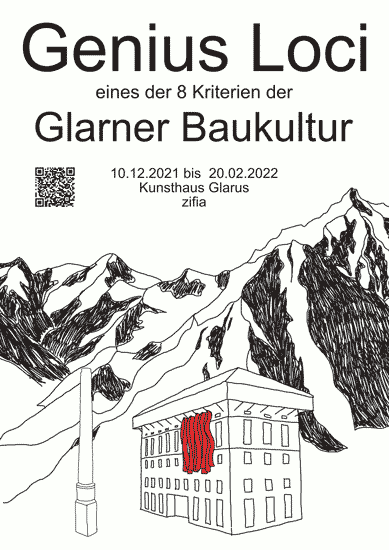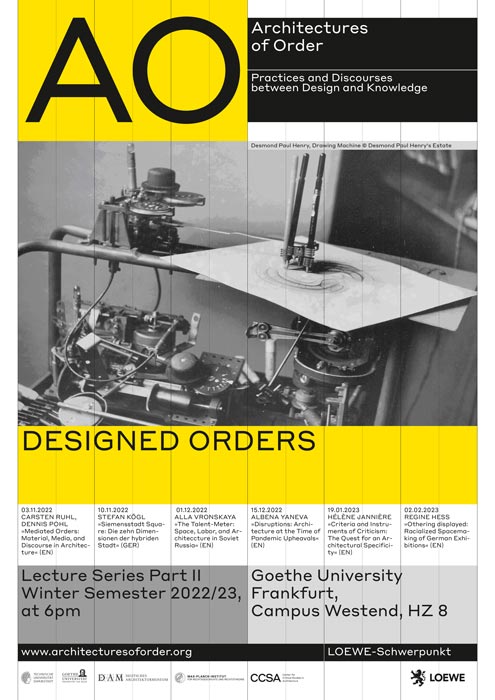MEDIATION IN
PRESERVATION
SEMINAR MASTER IN ADVANCED SCIENCE MAS, SPRING SEMESTER 2023
REGINE HESS
CHAIR CONSTRUCTION HERITAGE AND PRESERVATION, ETH ZURICH
The seminar for MAS students focuses on communicating scientific results in preservation. It offers an overview of methods of mediation in architecture and preservation and enables participants to communicate their research results. The scientific development of the properties and special features of a building or a preservation issue is used as a starting point to examine and apply innovative methods and interfaces of public communication.
The exhibition Blinde Flecken – Zürich und der Kolonialismus will be analyzed and discussed with the help of a questionnaire on curatorial practice. The city walk with the ZHkolonial app points out controversial buildings, biographies, and house inscriptions. Research in the Schweizer Sozialarchiv can be used to develop the historical-critical context of heritage objects. A meeting with the director of Schweizer Heimatschutz and a visit to Villa Patumbah will deepen the insights gained.
Designed Orders
Lecture Series
17.10.2022 – 10.02.2023
Goethe University Frankfurt
LOEWE Research Cluster:
Architecture of Order.
Practices and Discourses between Design and Knowledge
02.02.23
REGINE HESS (ETH ZUrich)
Othering Displayed:
Racialized Spacemaking of German Exhibitions
The architectural design process aims to create new orders and at the same time is, itself, structured by its practical, technical, social, and legal frameworks. The lecture series in the 2022/2023 summer and winter semester traces this double relation. Each design imagines the future and represents an attempt to create a new spatial – and thus always social – order. This projective access to the unknown and unthought places planning conventions, construction standards, legal requirements and established architectural, urbanistic and social ideas in relation to each other rethinks them, and makes them dynamic. The lecture series asks how design structures the interaction of these different and heterogeneous factors and what roles the conditions, norms, and tools of design play.
A FUTURE FOR WHOSE PAST?
ELECTIVE COURSE MONUMENT PRESERVATION, FALL SEMESTER 2022
REGINE HESS, ORKUN KASAP,
SILKE LANGENBERG
CHAIR CONSTRUCTION HERITAGE AND PRESERVATION, ETH ZURICH
The focus of the elective course lies on the heritage of minorities, marginalized groups and people without a lobby. This rarely considered heritage will be explored theoretically and practically through excursions, discussions and readings. The aim is to develop communication tools for presenting the 50th anniversary year of the European Heritage Year 1975 in public. Its motto was “A future for our past”. 50 years later, in view of the consequences of globalization, diversity, climate change, migration and war, we are faced with the question of who is meant by “us” at all. Whose heritage are we talking about, who determines what is important for society’s memory and with which heritage a society identifies?
In the fall semester of 2022, we will devote ourselves to the heterogeneity of architectural heritage and to critical approaches to monument preservation. Innovative methods and interfaces of public communication will be investigated and applied. The insights gained will flow into the preparation of a mediation campaign for the Heritage Year 2025.
Preservation:
Communicate &
Exhibit
Wahlfach Denkmalpflege,
Elective Course Monument Preservation,
Fall Semester 2021
Regine Hess, Fabian Kastner
Chair Construction Heritage and Preservation
ETH Zurich
Cooperation with S AM
Swiss Architecture Museum
The focus in the fall semester of 2021 was on various positions of monument preservation and their communication to the public on the part of monument preservationists, architects and curators. There were two narratives to be implemented, the mediation of which was tested at specific locations. The narrativ ecology/building in the existing stock was addressed by the Davos Baukultur Quality System, the gender narrative by the Gender Action Plan of ETH as well as the report of Engage DARCH.
The students examined exhibitions at the S AM in Basel (together with the director, Andreas Ruby) and at the Museum für Gestaltung in Zurich, the latter with the “Analysis Sheet Exhibition and Design”. This provided the basic knowledge with which the students themselves became active as curators and exhibition designers. Rusmir Ramic (Ramicsoenario, Berlin), an expert in participatory exhibition design, set the thought and design process in motion in his lecture with the question “How can human decision-making processes be visualized?”.
An important impulse was also given by Stéphane Mangenant (Game Technology Center/ETH Zurich) through his introduction in the game programming tool Candli. This shifted the design process to the digital space, which was evaluated by the final critique with Silke Langenberg and Orkun Kasap (Chair of Construction Heritage and Historic Preservation) and Yuma Shinohara (S AM).

Laura Franceschini, Building Culture of Glarn, Elective Course, Fall Semester 2021 © Laura Franceschini

For Wo*Men only
Gender Exclusive
Spaces
Seminar trip to Val Müstair, Grisons, Fall semester 2021
Silke Langenberg, Regine Hess, Robin Rehm
Construction Heritage and Preservation, ETH Zurich
Doing Gender is what Harold Garfinkel has called the everyday process by which we determine the gender of those who act. Doing Gender does not work without places in analog and digital space, in literature, in science, technology or history. Doing Gender makes architecture and shapes architectural heritage.
Val Müstair, with its many layers of religion and spirituality, building culture, arts and crafts, agriculture, industry and technology, as well as archaeology, monument preservation, world heritage and tourism, offers a fascinating space of investigation for femininity and masculinity in architectural heritage. Gender Exclusive Spaces play an important role in Doing Gender in monastery, forest and quarry, in kitchen and workshop. We explore their production and communication in both intuitive and cognitive ways by getting to know personalities and spaces, walking the valley, reading, discussing, and documenting.

Seminar Trip Group at Lai da Rims, Grisons © Laurianne Chassot
SUMMARY
ETH ZURICH
2021 – 2022
Chair Construction Heritage and Monument Preservation
BA-Seminars
Wahlfach Denkmalpflege: Vermitteln & Ausstellen, in collaboration with Prof. Dr. Silke Langenberg and Fabian Kastner
Seminartrip
For Wo*Men only. Gender exclusive Spaces, Kloster St. Johann, Müstair, in collaboration with Prof. Dr. Silke Langenberg and Dr. Robin Rehm
Focus Works
Berta Rahms Pavillon zur SAFFA58. Materialsammlung und denkmalpflegerisches Gutachten
Gender Exclusive Spaces
Das Kinderdorf St. Anton in Leuk von Heidi und Peter Wenger,
1970 – 1987
Archiviertes Konstruktionserbe
Women / Moms in Science
Technical University of Munich
2009 – 2019
Chair of History of Architecture and Curatorial Practice
Lectures
Die Internationale Bauausstellung Berlin 1957 und ihre Vorläufer
Die Stadt von Morgen: Die Internationale Bauausstellung Berlin 1957
The Interbau Berlin 1957 as City of Tomorrow
Die Internationale Bauausstellung Berlin 1957 und ihre Vorläufer
Die Moderne kehrt zurück. Die internationale Bauausstellung Berlin 1957
BA-Seminars
The Post-Catastrophic City: Ruins, Architecture, and Urban Resilience, in collaboration with Prof. Dr. Gabriella Cosentino Cianciolo
Nachkriegsarchitektur ausstellen – Bauprojekte aus dem Archiv, in collaboration with Dr. Anja Schmidt
Im Zeichen der Krise: Architektur, Theorie und Architekturausstellungen zwischen 1929 und 1949
MA-Seminars
Bauhaus In&Out: Von Weimar bis Tel Aviv
Shift of Scale. Postwar Architecture in Munich in its Contemporary Surroundings
Projektwerkstatt Kuratorische Praxis: Paul Schneider-Esleben und die Architektur seiner Zeit, in collaboration with Prof. Dr. Andres Lepik
MA-PROJEcTS
Architektur kuratieren. Analyse, Methode, Praxis, begleitendes Seminar, in collaboration with Dr. Hilde Strobl
Ausstellungsgestaltung/Exhibition Design, in collaboration with Prof. Dr. Andres Lepik and Dr. Vera Simone Bader
Excursions
Zelle der Zukunft. Geschichte und kuratorische Praxis von Bauausstellungen, Weißenhofsiedlung, Organisationsbüro IBA’27, Stuttgart
Bauhaus In&Out: Von Weimar bis Tel Aviv, Bauhaus-Universität Weimar, Bauhaus Dessau, Tel Aviv, Jerusalem, Haifa
Exhibition Making. From Concept to Design, Yad Vashem, The Israel Museum, Jerusalem
Im Zeichen der Krise: Architektur 1929–1949, Reichsparteitagsgelände, Dokumentationszentrum Nürnberg
Paul Schneider-Esleben und die Architektur seiner Zeit, Düsseldorf, Köln
Chair for the History of Architecture and Civil Engineering
MA-Seminars
Denkmäler für Krieg und Frieden in Europa seit 1800, in collaboration with Prof. Dr. Ing. Winfried Nerdinger
Analyse ungebauter Architektur des 20. Jahrhunderts, in collaboration with Prof. Dr. Ing. Winfried Nerdinger
Chair of Spatial Design
Lectures
Gestaltungsprinzipien von Peter Zumthor – emotionsanalytisch betrachtet, Gestaltungsprinzipien von Daniel Libeskind – emotionsanalytisch betrachtet
University of Kassel
2019/2020
Fachgebiet Architektur-geschichte
BA-Seminar
Zelle der Zukunft. Geschichte und kuratorische Praxis von Bauausstellungen
Tel Aviv University
2016
David Azrieli School
of Architecture
Workshop
Exhibition Making. From Concept to Design
Karlsruhe Institute
of Technology 2009/2010
Institut für
Bau- und Kunstgeschichte
Academic Exercise
Museumsausstellungen: Konzeption – Durchführung – Vermittlung



